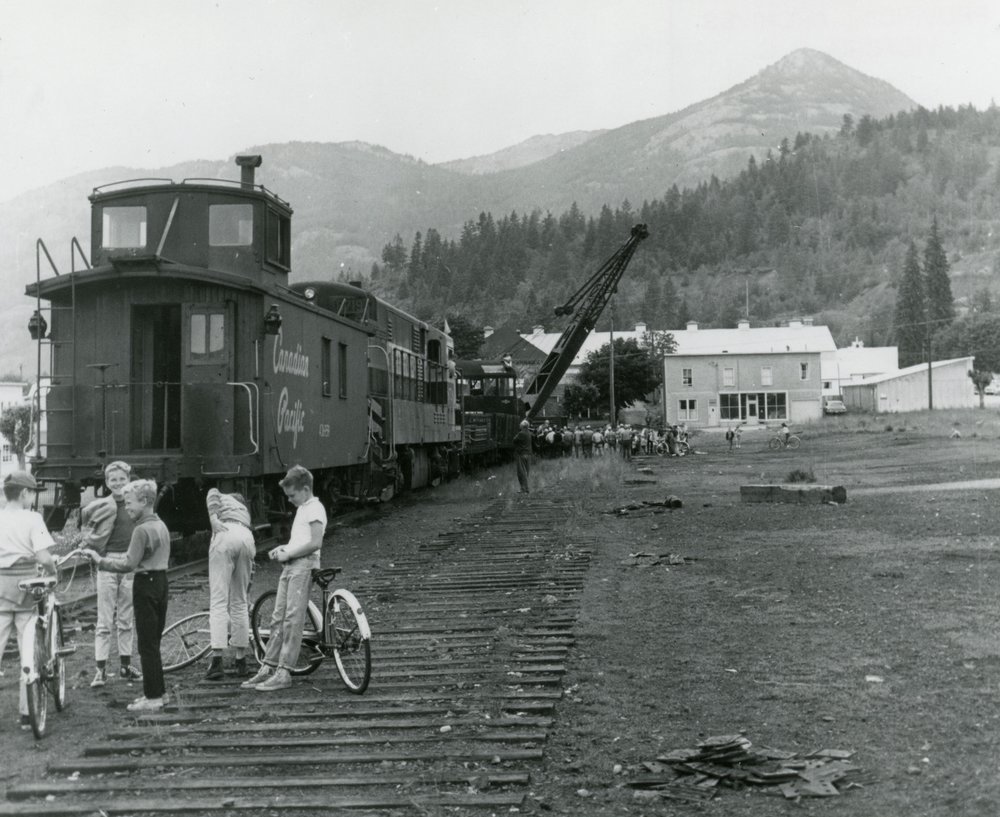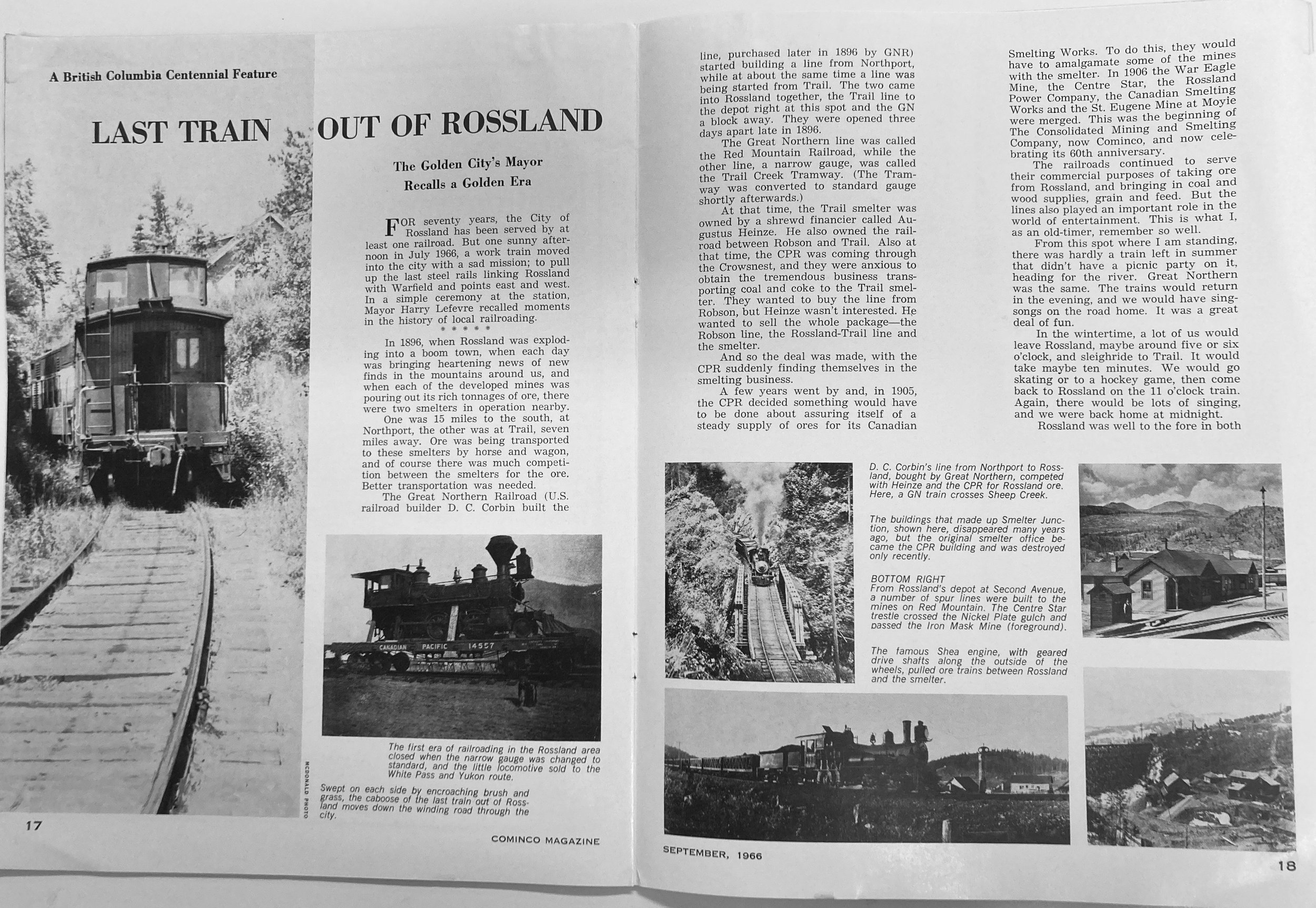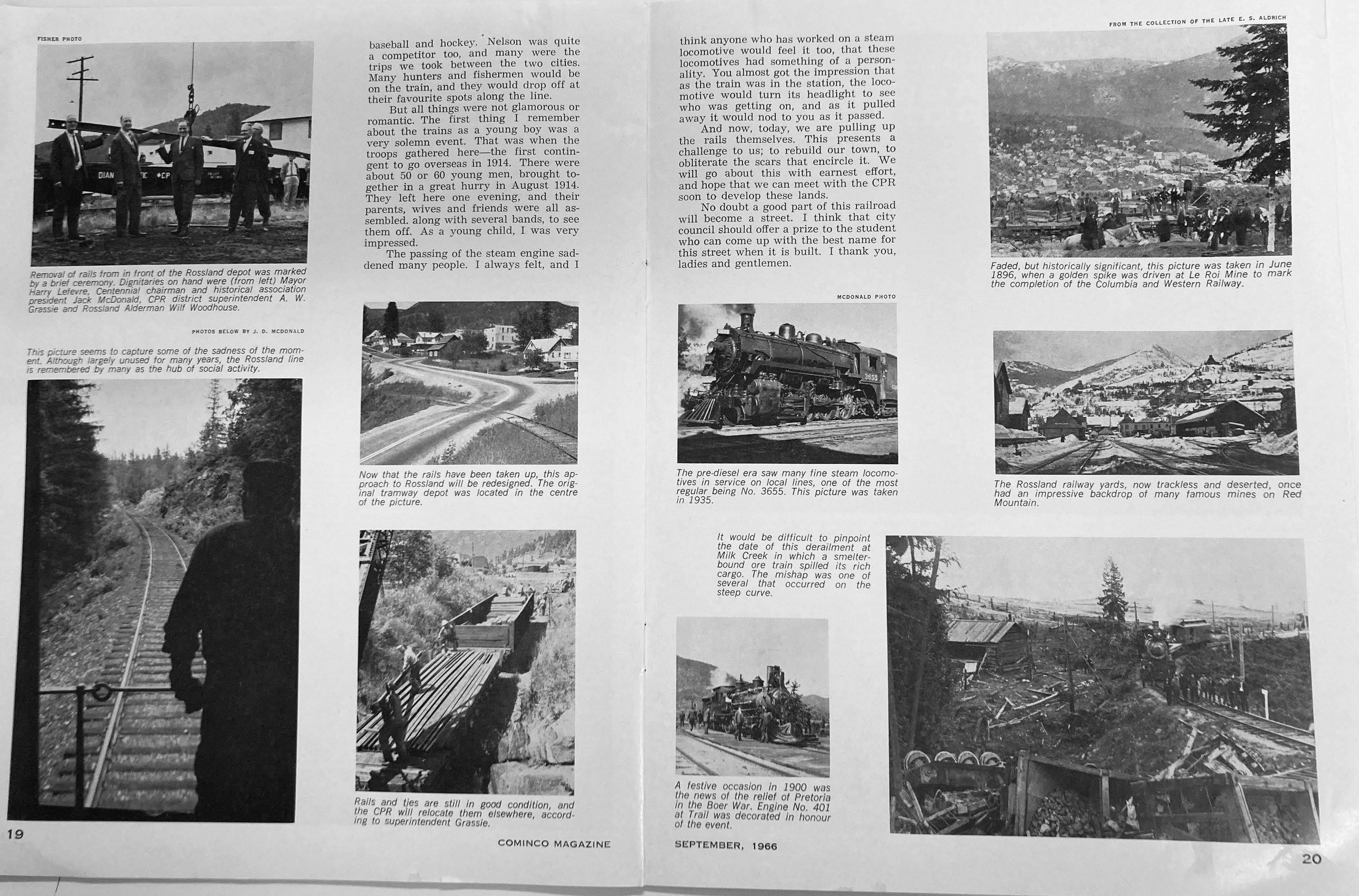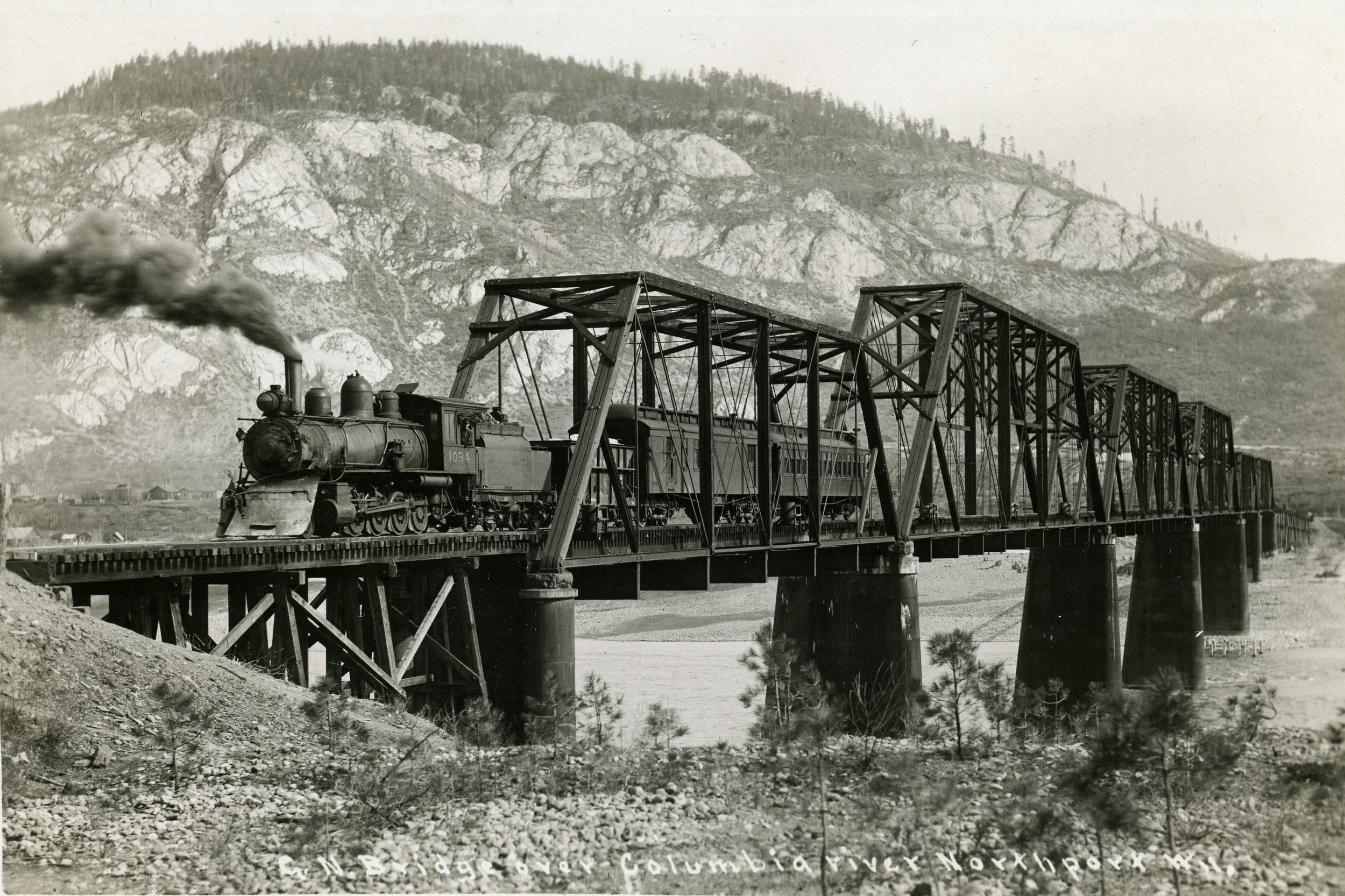This page is a work in progress - check back later for updates!
Railroads in Rossland
The First Railways
The large amounts of gold-copper ore extracted from the Rossland mines in the early 1890s led to a rush in railroad-building. Originally, ore needed to be carted by horse and wagon down a wagon road to connect to shipping routes to smelters in the United States.
Seeing the potential of the mines, Daniel C. Corbin of Spokane Washington decided to connect the Rossland mines to the rail network forming in the northern United States, so that Rossland ore would be connected by rail to American smelters. Having already built the Spokane and Northern Railway, which connected the stretch of Columbia River just below the Canadian border to the city of Spokane, Corbin hoped to build a railway from Rossland that would connect to this line. His proposed railway would be called the Red Mountain Railway, and it would travel from Northport up and across the border, and into Rossland and its mines. Corbin gained his charter for this line in 1893.
However, Corbin was not the only one who had his eye on Rossland. Montanan copper king Fritz Augustus Heinze had plans to build a smelter at Trail Creek and connect it by rail to the mines in Rossland. Heinze started construction of his railroad and smelter in 1895. Building the track, which climbed 2300 feet (700 meters) in elevation, required four switchbacks, and was a narrow gauge line which ran by the main mines as well as the city itself. Heinze completed his line, named the Columbia & Western, in 1896, with last ceremonious spike being nailed in June of that year. The first shipment of ore to the smelter came down Heinze’s line on June 11th, 1896.
When Corbin heard of Heinze and his plans he tried everything to expedite the process of building the line to Rossland, however he faced an unexpected issue; his track was planned to run through the Colville Indian Reservation, and as such he needed to gain approval from the President to build on the land. This road bump meant that despite his best efforts, it wasn’t until March of 1896 that he gained permission to lay the track. In the end Corbin’s Red Mountain Railway was completed 6 months after Heinze’s Columbia and Western, with the first passenger train to Spokane departing December 19th, 1896.
The first timetable of the Columbia and Western Railway, published in the Rossland Miner newspaper.
The Rossland CPR Train Station
The train station on the upper level of the museum grounds is modelled after the Canadian Pacific Railway (CPR) station that used to be on Second Ave. in Rossland. The CPR, alongside the Great Northern Railway, were present as passenger, ore, and freight trains in Rossland through the early 1900s. Although little evidence of the railways in Rossland remains, railroads were an important part of the early days of Rossland, both for the mines and the community.
Photo 2309.0252: In his rush to open the Red Mountain Railway Corbin used the cable ferry pictured, nicknamed the ‘Frail Dizzy’, to carry engines and cars across the Columbia River at Northport before the bridge, seen under construction in the background, was completed. The bridge was almost completed in May of 1896, however high flood waters washed it out, delaying completion until the autumn of 1896.
The first timetable of the Red Mountain Railway, published in the Rossland Miner newspaper.
+ Heinze and Corbin: Fierce Competitors
Heinze and Corbin both proved to be fierce competitors, and their squabble over Rossland became a well followed and dramatic ordeal. Ever a self-promoter, Heinze asserted himself as the ‘protector of Canadian interests’ in a fight against the greedy American Corbin. Despite being from the states himself, Heinze pushed that his interests lay in Canada, and, even further, that the infrastructure he was building would allow British Columbia to grow their industry and economy, rather than have the United States profit off of their resources.
Although it probably did not seem this way at the time, in the end the fight between the two men was beneficial for them both, as well for the city of Rossland. Both men found their rail lines profitable from the moment they opened. Although Heinze’s line scooped more of the ore load, Corbin’s connected the budding boomtown of Rossland with the metropolis of Spokane and became a well used passenger line. Further, alongside incentivizing the men to build their infrastructure faster, the battle over the ‘Golden City’ also led to increased interest in the place itself helping it to grow into the boomtown it had become at the turn of the century.
Buy-out by the Big Guys
Although Heinze and Corbin were the first to build railways to Rossland they did not last long, especially as two railway giants decided to use the Kootenay region as a war zone to settle their grievances with each other. This rivalry was between the Canadian Pacific Railway under President Van Horne and Great Northern under the reigns of James J Hill was made especially vicious as CPR saw the Kootenays as their territory, making their rival’s entrance even more inflammatory. CPR President Van Horne’s railway policy, which had helped them become the most expansive Canadian railway company, was to have his company keep up with the relevant Canadian trade routes and not allow for ‘foreign invasion’ by companies whose interests lay in the United States. This policy allowed the Canadian Pacific to gain many grants and subsidies from the Canadian government who saw the benefit of the company to the development of Canada. Contrastingly, Hill of Great Northern was very transparent that his interests lay with profits, and as such he looked to build feeder rail lines that would bring in the most return. He further denounced government help as ‘spoonfeeding’. It became clear that gaining control of the Kootenay region was more about settling the grievances both sides had than anything else, and thus there was no chance either side was going to back down.
The Canadian Pacific Buyout
The CPR announced their plans to build a railway to Rossland in 1897 and approached Heinze about buying his Columbia and Westerm Railway. At this time Heinze was worried that Corbin’s Northport smelter was beginning to steal his business, and as such was itching to get out before things went south. Seeing his opportunity, Heinze informed CPR that he would only sell the railway if they also bought his Trail smelter. Determined to have things swing in his favour, Heinze further bought the local newspaper, The Rossland Miner, for 25 thousand dollars and began publishing scathing articles about the CPR. With the pressure put on them both by their desire to out-compete Great Northern as well as to make a decision before their company name was defaced by fake news articles, the CPR agreed in 1898 to buy the railway and smelter for roughly 1 million dollars, a price equivalent to 22 million today. The company replaced the narrow gauge rail installed by Heinze with standard gauge, and on June 15, 1898, the first passenger train from Trail Creek serviced by the CPR arrived in Rossland.
“Unless that corporation immediately promises the public that it does not intend to monopolize the traffic of Kootenay, we shall be forced to the belief that the Canadian Pacific railway is determined to put the iron heel of oppression in the shape of a transportation monopoly upon the prosperity of every mine owner and merchant in Kootenay.”
The CPR train down the Rossland hill became the main method of transporting ore from the Rossland mines to the Trail smelter. Moreover, it was a useful commuter train for smelter employees throughout the first half of the 20th century, especially as mine operation ended in the late 1920s causing more Rossland workers to switch from mine work to a job at the smelter.
The Great Northern Buyout
It was apparent to Daniel Corbin for some time that someone was attempting to buy his Red Mountain Railroad as his stocks kept being bid up to ridiculously high prices. Assuming that this was someone from his parent company, Pacific Northern, Corbin did not mind, simply satisfied that his railway was a success. In 1898 Great Northern declared themselves as the mysterious stock buyers, who had now gained control of the Red Mountain Railway. Corbin was furious when he learned it was not, in fact, his colleagues, but rather Jim Hill of Great Northern who had taken his railroad from him.
The Great Northern had great success as a passenger service both to Northport - which Rosslanders thought was a lovely picnic destination - and Spokane. A very popular overnight train to Spokane was started in 1900, with tickets costing $1.50 one way. Moreover, despite not hauling much ore for the Northport smelter, the Great Northern turned quite a profit through the transport of other goods such as agriculture crops.
One of many alarmist headlines published in the Rossland Miner during Heinze’s time as an owner. This article, published Thursday September 30th 1897, alerted its readers that the CPR planned to monopolize the rail business in the Kootenays, which would be detrimental to all.
Canadian Pacific timetable, effective September 30th, 1917. (Click for a closer look)
The Route
Columbia and Western/Canadian Pacific
The Columbia and Western Railway was built with the main intention of servicing the Trail smelter, with a route snaking down the Rossland hill, through Warfield and Annabel, and arriving at the Trail smelter. From there, there was the option to enter the township of Trail, or to return back up the hill to Rossland. However, the line soon became connected to a much larger rail network under the ownership of the CPR. The Canadian Pacific was in the processes of constructing a coast-to-coast rail network when they gained ownership of Heinze’s line to Trail. As such, the line soon became connected to a network stretching out to the Okanagan, and later to the Pacific coast.
Red Mountain/Great Northern
As Corbin’s goal when he originally built the Red Mountain Railway was to bring Rossland ore to the Northport smelter, the line connected to the ever-expanding United States rail network. This network connected the mines, smelters, and major cities in the northern United States.
Map of the route of the Columbia and Western Railroad, bought in 1898 by the Canadian Pacific Railway. (Click for a closer look)
Map of the rail route of both the Red Mountain, later Great Northern, and Columbia and Western, later CPR, Railways within Rossland. The two railways had stations placed just a block apart. (Click for a closer look)
The End of Rail



The railroads which allowed Rossland to grow into a mining boomtown eventually lost their use. With business and mining both dwindling, the Great Northern applied to end their Rossland to Northport line in 1921. Despite being met with protest by the local community, who still enjoyed the convenient access to the Washington cities, in 1922 the line was shut down and the track removed.
The CPR trains managed to stay around a little longer. The closure of the mines in 1929 led to the end of ore services that same year. With highways becoming the new transportation standard, train travel began to become obsolete, and thus CPR ended their passenger services in 1937 and freight services in 1966.
“Great Northern departed from the local depot as usual on Friday morning.
With the arrival here of the afternoon train Thursday evening the Gt. Northern, for the present at least, has abandoned Rossland.”
For More Information:
McDonald, J.D/Rossland Historical Museum Association. Railways of Rossland British Columbia, 2nd ed. Trail, BC: Hall Printing Limited, 2012.
A newspaper article published in the Rossland Miner June 18th, 1921. Although the Great Northern no longer saw a value in keeping their Rossland line, the citizens of the town, who relied on the line both for recreation and business, saw otherwise. The closure of the Great Northern line caused quite an uproar, but in the end the city could not find a way to persuade the company to stay.
Continue the Outdoor Tour:
Contribute your own memories/experiences of the Railways in Rossland:
The form below will email us your message. If you prefer to speak to us directly or have other questions or comments about this page, please call (250) 362-7722 or email the archives directly at archives @rosslandmuseum.ca














